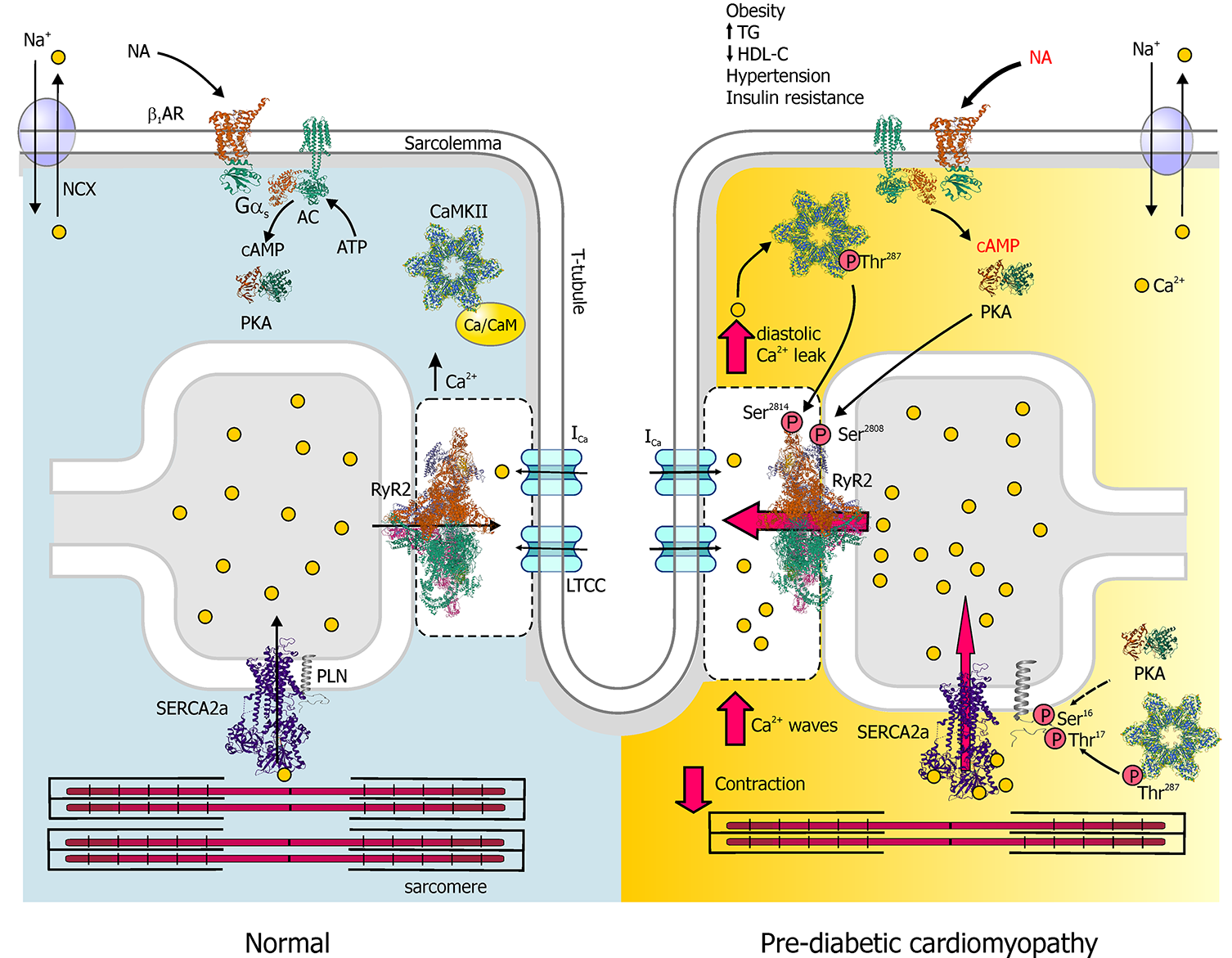Copyright
©The Author(s) 2021.
World J Diabetes. Oct 15, 2021; 12(10): 1704-1718
Published online Oct 15, 2021. doi: 10.4239/wjd.v12.i10.1704
Published online Oct 15, 2021. doi: 10.4239/wjd.v12.i10.1704
Figure 1 β-Adrenergic stimulation in the normal heart and pre-diabetic cardiomyopathy.
Left panel: β-adrenergic stimulation in the normal heart. In physiological excitation-contraction coupling, membrane depolarization activates L-type voltage-dependent Ca2+ channels, inducing a small Ca2+ influx (ICa) that triggers the activation of cardiac ryanodine receptors (RyR2, PDB accession code: 6WOV). This triggers the release of sufficient Ca2+ from the lumen of the sarcoplasmic reticulum to the cytoplasm to elicit contraction. During relaxation, Ca2+ is primarily removed from the cytoplasm by the sarcoplasmic reticulum Ca2+ ATPase (PDB accession code: 6HXB), which resequesters Ca2+ into the sarcoplasmic reticulum lumen. Ca2+ is also extruded by the Na+/Ca2+ exchanger (PDB accession code: 3US9), while a small amount of Ca2+ is taken up by the mitochondrial calcium uniporter (PDB accession code: 6WDN). Noradrenaline activates β1-adrenoceptors (β1-ARs, PDB accession code: 6H70) located at the sarcolemma of cardiomyocytes; agonist-bound β1-ARs stimulate Gas proteins and therefore one or more isoforms of adenylyl cyclase (PDB accession code: 6R3Q), leading to cAMP formation and the activation of the cAMP-dependent protein kinase (PDB accession code: 3FHI). Protein kinase A phosphorylates several Ca2+ handling proteins, including RyR2 at Ser2808 and phospholamban (PDB accession code: 2LPF) at Ser16; the latter increases sarcoplasmic reticulum Ca2+ ATPase pump activity. Ca2+ binds to calmodulin, and the complex Ca/calmodulin binds to and activates Ca2+/calmodulin-dependent protein kinase II (PDB accession code: 3SOA), which phosphorylates RyR at Ser2814 and phospholamban at Thr17. The exchange protein directly activated by cAMP (Epac) is also involved in Ca2+/calmodulin-dependent protein kinase II activation; however, its role in pre-diabetic cardiomyopathy has not yet been addressed; thus, it is not depicted in the figure. Right panel: β-adrenergic stimulation in pre-diabetic cardiomyopathy. In the presence of obesity, increased triglyceride levels, decreased high-density lipoprotein cholesterol, hypertension, and/or insulin resistance (all Metabolic Syndrome components), and abnormal β1-AR activation (associated with either chronic sympathetic tone or changes in β-AR expression) dysregulates excitation-contraction coupling in cardiac cells. Pre-diabetic cardiomyopathy is characterized by abnormal diastolic Ca2+ leak (diastolic dysfunction) due to augmented RyR2 phosphorylation at Ser2808 and Ser2814 in the absence of adrenergic stimulation, generating spontaneous Ca2+ waves that may induce pro-arrhythmogenic events through altered Na+/Ca2+ exchanger activity. In addition, phosphorylated phospholamban (at Ser16 and Thr17) detaches from sarcoplasmic reticulum Ca2+ ATPase 2a, augmenting its activity; finally, Ca2+ transient amplitude decreases and leads to impaired cell contraction. NA: Noradrenaline; AR: Adrenoceptors; NCX: Na+/Ca2+ exchanger; AC: Adenylyl cyclase; PKA: Protein kinase A; CaMKII: Ca2+/calmodulin-dependent protein kinase II; CaM: Calmodulin; RyR: Ryanodine receptor; LTCC: L-type voltage-dependent Ca2+ channels; PLN: Phospholamban; HDL-C: High-density lipoprotein cholesterol; TG: Triglycerides; SERCA: Sarcoplasmic reticulum Ca2+ ATPase.
- Citation: Gaitán-González P, Sánchez-Hernández R, Arias-Montaño JA, Rueda A. Tale of two kinases: Protein kinase A and Ca2+/calmodulin-dependent protein kinase II in pre-diabetic cardiomyopathy. World J Diabetes 2021; 12(10): 1704-1718
- URL: https://www.wjgnet.com/1948-9358/full/v12/i10/1704.htm
- DOI: https://dx.doi.org/10.4239/wjd.v12.i10.1704









